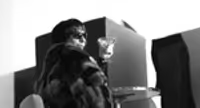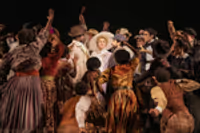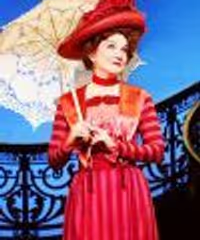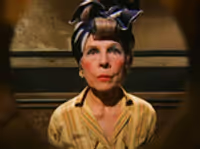Groban & Ashford in SWEENEY TODD On Broadway - Reviews & News Thread
jimmycurry01
Broadway Legend Joined: 5/28/05
#575SWEENEY TODD Revival announces further casting
Posted: 3/1/23 at 12:27pm
dramamama611 said: "Replacing actors seldom happens. Not never, but seldom."
Very true, but the number is higher than one would expect, with some even being particularly noseworthy... er noteworthy.
#576SWEENEY TODD Revival announces further casting
Posted: 3/1/23 at 12:48pm
I was there last night and liked it, but didn't love it - and I went in wanting to love it, so I can't help but feel a bit let down. I don't have much to add that hasn't been said here already, but here are a few thoughts.
The omission of the factory whistle is a huge, huge misstep. I missed it at so many points throughout the night - at the very top of the show, throughout "City on Fire," during many of the killings. It does so much to help set the tone of the show, and there were many moments that would have packed more of a punch had the whistle been present.
I also left last night finding myself in the "more blood" camp; I liked the blood during the Act II "Johanna" sequence and would have liked to have seen more throughout. There was a bit during the final killings, but I really felt like they could have gone further. Between the whistle and the blood, it seemed like this production was stepping away from the "thriller" part of "A Musical Thriller," and I wish they had leaned into that a bit more.
I really enjoyed both leads, and was especially impressed with how Ashford balanced humor with some of the quieter, more emotional moments of Mrs. Lovett. I thought Ruthie Ann Miles was absolutely phenomenal as the Beggar Woman, and, if it were up to me, she'd be nominated for a Tony in a few months for her performance. She builds a complete, complex character, even with limited stage time; there are shades of the Lucy she once was from her very first scene, making her circumstances all the more tragic.
While I wish the set had taken a bit more inspiration from the original designs, I thought it was effective in both its design and aesthetic, and I particularly enjoyed when the bridge tilted during "City on Fire," creating a stage picture that (from the mezzanine, at least) really reflected the text. I also enjoyed the final moments of each act, particularly the second, and I imagine that would have played even better had I been sitting in the orchestra.
As for the music: the 26-piece orchestra was my biggest selling point for this production, and, unfortunately, it didn't deliver the way I had hoped. I agree with others here that the orchestra sounded distant; this is perhaps just a sound design issue, and one that can hopefully be worked out as previews continue. But from where I was sitting, the music just didn't fill the space. The OBCR is pretty much the only recording of Sweeney that I listen to, and it's largely because of the orchestrations. I was so excited to hear them finally played in a Broadway theater, but, last night, they never sounded quite as full as I wanted them to.
I feel like I've mostly listed my gripes here, which is making me come across harsher than I mean to. Like I said at the top of my post - I liked the production, it just didn't blow me away the way I was hoping. I would consider revisiting it at some point in the future, likely after opening - hopefully by then they'll have been able to work out any sound design issues and will have (pretty, pretty please!) added in the whistle. Those two things alone may be enough to completely win me over.
#577SWEENEY TODD Revival announces further casting
Posted: 3/1/23 at 1:06pm
Fisher does not need to be replaced. It's not that severe!
#578SWEENEY TODD Revival announces further casting
Posted: 3/1/23 at 1:21pm
We should rest assured that the Sound Design will improve. Suddenly adding 1500 bodies to the auditorium changes the design considerably. The goal of the first preview is for everyone to be heard; after that is when you find nuances and subtleties.
SWEENEY has one of the best sound designers in the biz, Nevin Steinberg, who in addition to HAMILTON did excellent sound design for the mostly-acoustic scores of PORGY & BESS and LIGHT IN THE PIAZZA and CINDERELLA and FIDDLER and Bernadette's GYPSY. They also have an expert music braintrust in Alex Lac, David Lai, Fred Lassen, and Tunick himself who has been very present.
Give them a week.
ElephantLoveMedley
Broadway Star Joined: 10/14/21
#579SWEENEY TODD Revival announces further casting
Posted: 3/1/23 at 1:37pm
Chiming back in again to say I do think that adding the factory whistle in would improve this production. And I say that as a big fan of what they’re doing already. But the production could certainly benefit from a little more horror/thriller vibes.
Updated On: 3/1/23 at 01:37 PM#580SWEENEY TODD Revival announces further casting
Posted: 3/1/23 at 1:47pm
ElephantLoveMedley said: ". But the production could certainly benefit from a little more horror/thriller vibes."
This is exactly how I feel.
Was Pirelli’s death still done in the dark? I feel the show’s first death should be a highlight.
Dan6
Broadway Star Joined: 8/7/10
#581SWEENEY TODD Revival announces further casting
Posted: 3/1/23 at 1:49pm
What are the rules on plot spoilers for a 44-year-old show? I know Sweeney well, having seen every one of the major NY productions going back to the original, but I don't assume that everyone else does. Yet the above posts are filled with descriptions of what characters get killed and even who a certain character "once was," none of which are hidden behind spoiler tags. I'd hate to have the experience of someone new to the show ruined by coming to this board to learn about the production and the cast, and instead unintentionally finding major plot points and twists given away.
#582SWEENEY TODD Revival announces further casting
Posted: 3/1/23 at 1:52pm
I was using spoilers Sunday, but I noticed most of the show has already been spoiled so there’s nothing to really hide now. As you said, it’s not a new musical. It’s kind of hard to avoid spoilers for this show.
#583SWEENEY TODD Revival announces further casting
Posted: 3/1/23 at 1:53pm
I think this a production that will tighten and improve throughout the preview process. I'm not seeing it for a few more weeks, and while the anticipation is killing me, maybe that's not such a bad thing.
Dolly80
Broadway Star Joined: 5/15/11
#584SWEENEY TODD Revival announces further casting
Posted: 3/1/23 at 3:44pm
WHY would you even want to get rid of the whistle? That’s bizarre to me.
#585SWEENEY TODD Revival announces further casting
Posted: 3/1/23 at 5:09pm
This Factory Whistle saga feels like Sally's red dress all over again!
#586SWEENEY TODD Revival announces further casting
Posted: 3/1/23 at 5:12pm
ErmengardeStopSniveling said: "This Factory Whistle saga feels like Sally's red dress all over again!"
Or the most recent Annie revival that didn't have the overture at the first few previews!
JasonC3
Broadway Legend Joined: 4/22/21
#587SWEENEY TODD Revival announces further casting
Posted: 3/1/23 at 5:30pm
ErmengardeStopSniveling said: "This Factory Whistle saga feels like Sally's red dress all over again!"
Mashup for future revivals:
the Red dress finds its way into Sweeney
the whistle makes it way to Follies
#588SWEENEY TODD Revival announces further casting
Posted: 3/1/23 at 6:12pm
Dolly80 said: "WHY would you even want to get rid of the whistle? That’s bizarre to me."
I guess one can't criticise capitalism and charge those prices at the same time! Seriously tho, it's a pity it's not there
#589SWEENEY TODD Revival announces further casting
Posted: 3/1/23 at 6:51pm
bwayphreak234 said: "ErmengardeStopSniveling said: "This Factory Whistle saga feels like Sally's red dress all over again!"
Or the most recent Annie revival that didn't have the overture at the first few previews!"
Or Danny Burstein's red parka.
Sometimes knickers get too twisted over here.
#590SWEENEY TODD Revival announces further casting
Posted: 3/1/23 at 7:41pm
Unrelated to the actual show, but have the banners been taken down on the exterior of the Lunt? From recent photos on instagram they are gone....
#591SWEENEY TODD Revival announces further casting
Posted: 3/1/23 at 7:53pm
Genuine question:
Is the factory whistle in the stage directions and/or the written score? I was in the show 10 years ago, and I'm pretty sure we had it - but I don't know if we had it because it was written in, or because our director was just emulating the original. And I don't own the libretto or score to check.
Anyway, I guess I'm asking because: if it's NOT written in, then it's not really fair to say they "got rid" of it. If it was just a stylistic choice that Hal Prince made, then you can't really be mad at them for NOT copying someone else's directorial choice.
#592SWEENEY TODD Revival announces further casting
Posted: 3/1/23 at 8:01pm
Though we know we would never SING along to Sweeney Todd, I propose we all sneak in a factory whistle and let ‘er rip at the appropriate moments.
Updated On: 3/1/23 at 08:01 PM#593SWEENEY TODD Revival announces further casting
Posted: 3/1/23 at 8:06pm
Could the lack of the factory whistle have anything to do with the 500,000 social media posts (many of them here) that demand to know whether there are (EEK) gunshots during the performance of every play and musical that opens every year? Because, if there are, you know, I really can’t be subjected to the unexpected aural assault that will stay with me for days.
JasonC3
Broadway Legend Joined: 4/22/21
#594SWEENEY TODD Revival announces further casting
Posted: 3/1/23 at 8:40pm
JoeW4 said: "Genuine question:
Is the factory whistle in the stage directions and/or the written score? I was in the show 10 years ago, and I'm pretty sure we had it - but I don't know if we had it because it was written in, or because our director was just emulating the original. And I don't own the libretto or score to check.
Anyway, I guess I'm asking because: if it's NOT written in, then it's not really fair to say they "got rid" of it. If it was just a stylistic choice that Hal Prince made, then you can't really be mad at them for NOT copying someone else's directorial choice."
I'm with you in spirit a bit, but then all we need to do is just start saying "I can't believe they didn't include the whistle that was so thrilling in the original production. That really ticks me off."
I mean, it's just semantics at that point.
#595SWEENEY TODD Revival announces further casting
Posted: 3/1/23 at 9:34pm
FANtomFollies said: "Unrelated to the actual show, but have the banners been taken down on the exterior of the Lunt? From recent photos on instagram they are gone...."
Yes, and the theatre currently looks like it’s covered in dildos.
I’m surprised there wasn’t anything in the budget for Sweeney banners.
#596SWEENEY TODD Revival announces further casting
Posted: 3/1/23 at 9:44pm
Interesting factory whistle trivia from Margaret Hall's "Paul Gemignani - Life and Lessons from Broadway and Beyond":
It was Gemignani's idea to use the factory whistle effect. The sound was originally orchestrated to be a gong struck by the percussionist.
The prop master quickly located a real Victorian-era factory whistle.
Because it was so earsplittingly loud, the whistle had to be moved to the far back of the set to keep from hurting everybody in the theatre. (It would cause ear ringing.)
Gemignani insisted that the whistle be triggered by the conductor because it gave Cariou more freedom of time with the murders.
A button was installed at Gemignani's feet at the conductor's podium. When it was time for the whistle, Gemignani pressed the button with his foot.
#597SWEENEY TODD Revival announces further casting
Posted: 3/1/23 at 10:08pm
morosco said: "Interesting factory whistle trivia from Margaret Hall's "Paul Gemignani -Life and Lessons from Broadway and Beyond":
It was Gemignani's idea to use the factory whistle effect. The sound was originally orchestrated to be a gong struck by the percussionist.
The prop master quickly located a real Victorian-era factory whistle.
Because it was so earsplittingly loud, the whistle had to be moved to the far back of the set to keep from hurting everybody in the theatre. (It would cause ear ringing.)
Gemignani insisted that the whistle be triggered by the conductor because it gave Cariou more freedom of time with the murders.
A button was installed at Gemignani's feet at the conductor's podium. When it was time for the whistle, Gemignani pressed the button with his foot."
I totally forgot about that and I read the book. Thank you for sharing that".
halfhourcheckwithmerman
Stand-by Joined: 9/25/22
#598SWEENEY TODD Revival announces further casting
Posted: 3/1/23 at 10:11pm
what a great story!!
Blindbutlerdeafmaid
Chorus Member Joined: 8/15/13
#599SWEENEY TODD Revival announces further casting
Posted: 3/1/23 at 10:14pm
Without posting links to what is mostly certainly copyright violations there seem to be several publicly available (and easily Google-able) pdf copies of the score around the internet, including both the stock and amateur licensable MTI Conductor Score and a Piano Score that is based on "the composer's piano copy rather than the piano conductor" (interesting note on the bottom of page 3 about the score).
Both scores have the organ part clearly building to the whistle and in both the whistle is both notated with an un-pitched instrument notation as well as mentioned in the stage direction. I'm sure someone can correct this if it is incorrect, but it appears to me that both the accelerando and the crescendo are intended to extend into the whistle with the conclusion of the crescendo, the fortississimo marking, sitting directly under the whistle notation and stage direction. Neither score has the organ smudge (?) that accompanies the whistle on the OBC. The Prelude is marked optional in both scores.
The stock/amateur license version of scripts/scores usually contain stage directions that aren't in the production scripts and this one is missing the police warden and the workmen, both of whom have the stage directions that are mentioned in the piano score.
However, after all that, who knows if they were Wheeler Sondheim ideas or a Prince production idea, but because of the way the organ solo builds, stops, and the way the crescendo and accelerando are marked, my thinking is that if you perform the Prelude, it should at least end with the whistle. (I would imagine, either way, that omitting it was discussed among the rights holders when the rights for this production were negotiated.)
Others can scroll through any of the scores to find if the others are written into either score. They truly are widely available.
Videos













